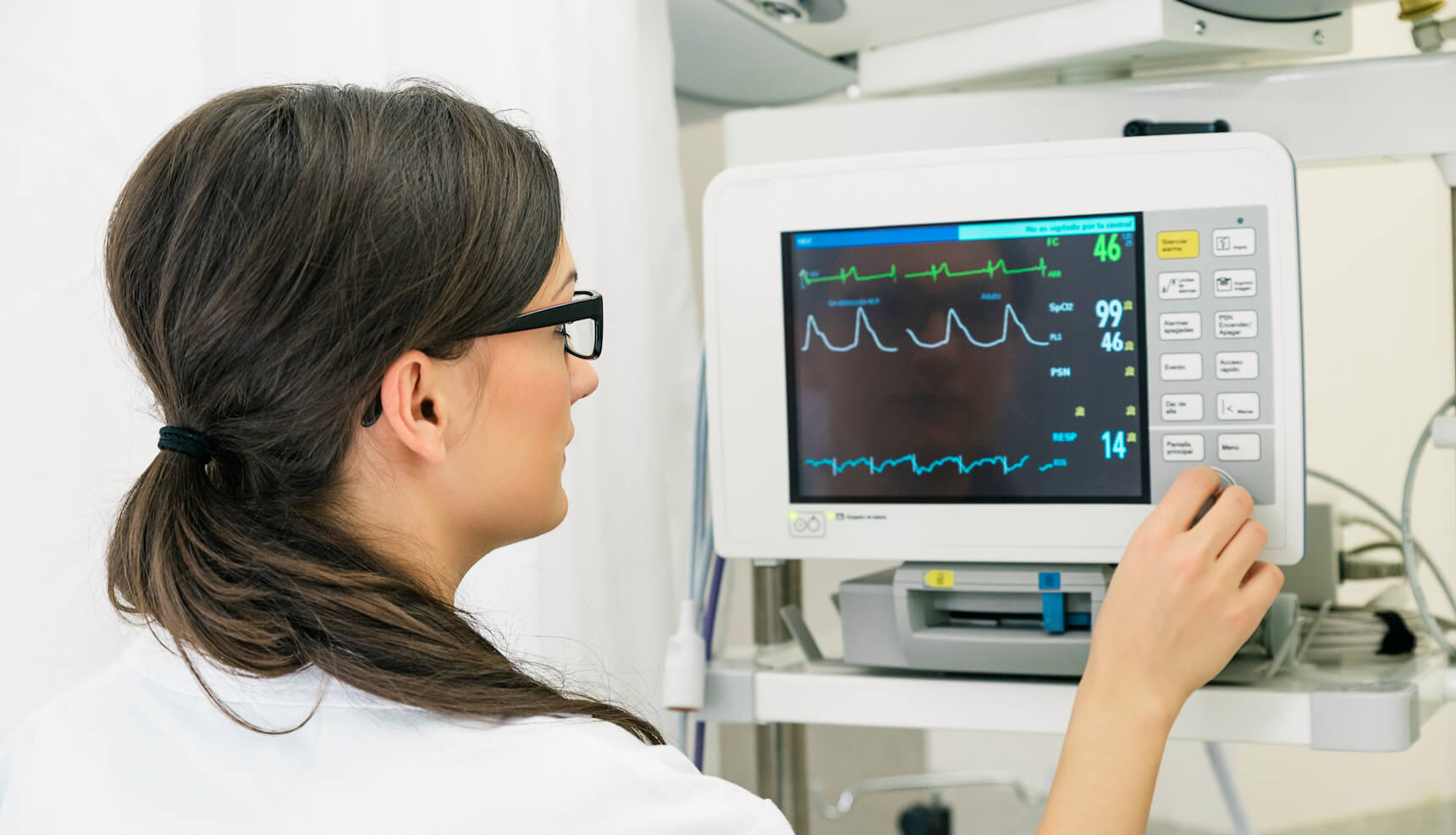Ventricular fibrillation, or Vfib, is an abnormal cardiac rhythm where the electrical conduction in the ventricles goes wild, causing 350 to 600 impulses per minute. As a result, the ventricles quiver instead of contracting fully, preventing blood from pumping in the body leading to death.
The quickest and most painless way to diagnose ventricular fibrillation is with an ECG, making it one of the more important topics we cover in all of our ECG interpretation courses. This article will cover general information about Vfib, its causes, risk factors, symptoms, diagnosis, treatment processes, and whether it is preventable.
What Causes Ventricular Fibrillation?
Ventricular fibrillation’s causes may not be immediately distinguishable. Usually, it occurs after a cardiac event like a heart attack. Realize that other conditions that injure the heart can also lead to ventricular fibrillation. Another example is myocarditis or an idiopathic cardiomyopathy.
When you look at an electrocardiogram, you may notice two different presentations of ventricular fibrillation. The first, course-Vfib, shows taller peaks and troughs of the QRS waves and predicts a better overall survival rate. The second, fine-Vfib, shows a fine squiggly line and confers a very poor outcome.
Other causes of ventricular fibrillation include:
- Electrolyte imbalances (specifically insufficient potassium levels)
- Medications that interrupt the body’s electrical impulses
- Hereditary medical conditions
- Electrical shock
- Sepsis
- Blunt trauma
- Other heart-related medical issues
Who Is at Risk for Ventricular Fibrillation?
Ventricular fibrillation most commonly affects those with already weakened heart muscles as the weak heart tissue causes abnormalities in the electrical system. People who are at risk for ventricular fibrillation include people with:
- Existing heart issues: Heart arrhythmia, myopathy, blood pressure issues, and other heart-related conditions put people at risk for further problems.
- Genetic heart diseases: Cardiomyopathy, Long QT syndrome, and other hereditary diseases automatically raise the risk as the heart is less immune to problems.
- Previous history of heart attack and other heart-related conditions: Heart attacks weaken the heart muscles and alter the conduction system, increasing the risk for ventricular fibrillation significantly.
- Consistent electrolyte issues: Too little or too much potassium or magnesium may also increase the risk.
- Medications or illegal drugs that disrupt heart activity: Certain prescription drugs and illegal substances can interact with the heart’s electrical signals. Methamphetamine, cocaine, and other illicit drugs may induce ventricular fibrillation.
What Are the Symptoms of Ventricular Fibrillation?
While identifying ventricular fibrillation requires an ECG or rhythm strip, some symptoms may precede the event. Often, symptoms occur due to an impending heart attack or another rhythm disturbance. These symptoms may include:
- Chest pain
- Racing pulse or erratic heartbeat
- Dizzy spells or nearly fainting
- Nausea
- Heart palpitations
- Fainting
- Shortness of breath
When Vfib occurs, there is essentially no blood circulation in the body, which causes syncope (loss of consciousness) and death. Sudden onset of Vfib, often associated with an acute heart attack (myocardial infarction), is a common cause of sudden cardiac death. As you might imagine, ventricular fibrillation requires immediate medical attention, including cardiopulmonary resuscitation (CPR) and defibrillator use.
Reducing the Risk for Vfib
While Vfib can occur for various reasons, there are ways to reduce your risk. The most vital advice is to keep your heart healthy. Eating a heart-healthy diet, getting regular exercise, managing blood sugar and cholesterol, and refraining from smoking and drug use can all help reduce the risk for Vfib.
Medical professionals often recommend medications to control and manage abnormal heart rhythms and prevent symptoms and death. Additional medical treatment includes getting an implantable cardioverter-defibrillator (ICD). An ICD monitors the heart for ventricular tachycardia and ventricular fibrillation and then shocks the heart if it detects a serious rhythm abnormality.
How Is Ventricular Fibrillation Diagnosed?
Only an electrocardiogram or a rhythm strip diagnoses ventricular fibrillation. Since Vfib causes unconsciousness and sudden cardiac death, getting a rhythm strip or automatic external defibrillator (AED) on an unconscious patient is crucial. As mentioned above, ventricular fibrillation looks like a fine squiggly line on the ECG. There are no organized P-waves, QRS complexes, or T waves, and this erratic baseline can be fine or coarse. Course Vfib has higher peaks and troughs in the waveforms but causes the same signs and symptoms.
The diagnosis begins with the medical provider performing a thorough history and physical examination for patients at risk for ventricular fibrillation. The provider listens for symptoms and clues of risk for cardiac disease or other potential Vfib causes. The provider examines specific signs, like heart murmurs, cardiac heaves, or irregular heartbeats. The doctor obtains vital signs, including heart rate and blood pressure.
A baseline ECG is an essential test. The provider looks for rhythm and waveform abnormalities that put patients at risk. Additional tests may include:
- Blood Test
- Chest X-ray
- Echocardiogram
- Coronary catheterization (angiogram)
- Cardiac computerized tomography (CT)
- Cardiac magnetic resonance imaging (MRI)
How Is Ventricular Fibrillation Treated?
Once ventricular fibrillation is diagnosed, it must be treated as soon as possible. The most crucial treatment is defibrillation, which needs to be done immediately. Defibrillation is applying an electric shock to the heart, and this shock stops Vfib and allows the heart rhythm to reset to normal. This is accomplished with an automatic external defibrillator (AED) in the outpatient setting. These devices are now available all over, such as airports, shopping malls, and many other places. Every Good Samaritan who comes across an unconscious person should begin CPR, get an AED, and follow the instructions. In a hospital setting, emergency medical providers will use a manual cardioverter-defibrillator, which allows them to see the abnormal rhythm and decide the appropriate treatment. Using an AED or applying a shock to ventricular fibrillation in the first three minutes of a person collapsing increases survival up to 95%.
People who survive ventricular fibrillation have an increased risk of it happening again. Patients are treated with antiarrhythmic medications and usually receive an internal cardiac defibrillator (ICD). Wires are typically placed into the heart through the veins under the collarbone. These wires are attached to a computerized device that is then implanted into a pocket under the skin and under the collarbone in the anterior chest. ICDs monitor the heart 24/7 for Vfib. If they detect Vfib, they give the heart a shock to abort the abnormal rhythm immediately.
Can Vfib Be Prevented?
Prevention and treatment for Vfib are very similar due to the limited options for restoring heart health. While there is no way to eliminate Vfib’s risk factors, it is preventable. By treating the underlying health issues that could cause ventricular fibrillation, the heart becomes less susceptible to falling out of rhythm.
Exercising daily and managing a healthier diet can improve heart health and prevent ventricular fibrillation. Regular ECGs may be necessary to monitor the underlying rhythm and heart health. Other prevention methods include taking antiarrhythmic medications and internal cardiac defibrillators.
Can Vfib Be Managed?
Vfib is manageable if patients follow doctors’ orders. Managing the potential triggers may require further treatment, such as surgery to eliminate electrical triggers in the heart or implanting a device to automatically shock the heart into its proper rhythm. People who have had previous Vfib issues should strictly follow directions for controlling their arrhythmia.
It’s vital to ensure a Vfib sufferer’s loved ones know how to handle the situation if they have an emergency. Families and patients should stay educated on performing CPR and what to do during fibrillation.
Learn To Identify Vfib & Other Heart Issues On An ECG
Learning to identify Vfib and other heart conditions on an ECG is an invaluable skill for any medical professional to have. ECGEDU.com offers several EKG interpretation classes for all medical professionals, including doctors, medical students, nurse practitioners, nurses, EMTs, and even techs.
If you’d like to get a feel for our online lesson format and Dr. Siegal’s approach to instruction, you can sign up for our free ACLS Rhythms Course. You can also sign up for our ECG Premium Course and get access to all of our courses at once. Don’t hesitate to contact us today if you have any questions.




